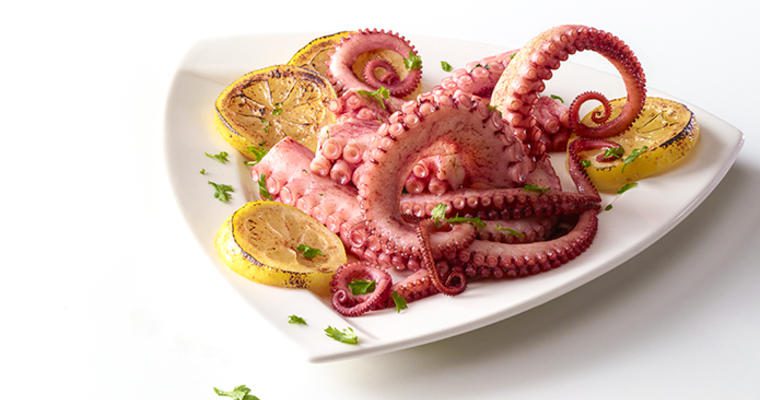Octopus has gained traction on menus across the country, propelled by the modern seafood trend, which sees chefs applying flavor-forward techniques to seafood-centric shareables, snacks and more.
“The first time in our external research that we saw activity around octopus was in 2014,” says Gordon Food Service Corporate Consulting Chef Gerry Ludwig, CEC. “We created a whole host of recipes back then, mainly appealing to restaurants with more adventurous menus.” Octopus was leading-edge then, but our 2018 street-level research demonstrates it’s moving more toward mainstream.
Ludwig points out the great opportunity with octopus. “It’s extremely versatile, the price is reasonable and it offers great menu differentiation,” he says. He also notes today’s diners see it as more special than most seafood. Most consumers won’t cook it at home, which adds to its menu allure. “And on top of that, octopus brings dramatic plate presentation, wowing with long, curled tentacles,” Ludwig says. “We also think it’s primed for handhelds, like parathas, naan and tacos.”
During the research tour, where Ludwig and his team sampled menus from new restaurants in Chicago, Los Angeles and New York, he saw a tremendous amount of creative menu applications featuring octopus. He shares four ways chefs are menuing octopus with opportunity for wider menu translation.
Octopus partners with other seafood
“Octopus is really nice in seafood stews like a cioppino or bouillabaise,” Ludwig says. It adds a nice heartiness to those kind of broth-based dishes. Paella, other seafood fried rice dishes and seafood medleys over pasta also welcome octopus to the mix.
Menu Example:
- Chapuzon: Tiger shrimp, Spanish octopus, tilapia, romaine salad, epazote rice, micro cilantro, salsa cruda—La Josie, Chicago
Creamy Sauces
Menu Examples:
- Grilled Baby Octopus with new potato, harissa, raw corn, artichoke, arugula, pistachio-yogurt panna cotta, forbidden rice—Eden, Chicago
- Grilled Octopus with crispy papas, agave-jalapeño, roasted tomato mayonesa—Barrio, Chicago
Bean purées
Another treatment was bean purée. “Chefs are making a flavorful bean-based purée and using it as base sauce for the octopus,” Ludwig says. It’s fueled by the veg-centric movement and the interest in Mediterranean flavors.
Menu Examples:
- Grilled Octopus Pita with smoked hummus, tabbouleh, crunchy edamame, house harissa—The Tortoise Supper Club, Chicago
- Octopus with a cannellini-bacon purée, cherry tomato pesto—Mar Vista, L.A.
Boldly flavored meat pairings
We found octopus marries well with boldly flavored meats, linguiça, hams, smoked sausage—any meat with an assertive profile. It’s a classic pairing in Spanish cuisine. Chefs are taking that flavor and texture combination and deepening the umami.
Menu Examples:
- Sweet Chili Charred Octopus with Chinese sausage, fingerlings, scallions, white bean purée, preserved lemon—Motel Morris, NYC
- Grilled Octopus with Benton’s country ham, smoked fingerlings, burnt orange—Sweet Chick, L.A.
- Octopus and morcilla, tomatillo, smoked potato—Camperdown Elm, NYC
Culinary Tips
The Gordon Food Service culinary team has developed this method to create tender, flavorful octopus:
- Use flavorful braising liquids that won’t overpower the octopus, such as seafood stock with a mix of mirepoix, aromatics, and red wine or sherry vinegar.
- Bring the liquid to a boil, dip tentacles so they seize up and curl, then turn to simmer and put tentacles in.
- Slow-simmer the octopus, testing it with a fork for doneness; when you can pierce the skin without getting a grab, it’s done (don’t overcook, or the suckers will come right off).
- Grill or pan-sear cooked octopus until nicely charred and crispy.
Learn More
Ask your Sales Representative about our recipes for both flavor-forward octopus dishes and product information on our frozen whole octopus product.











